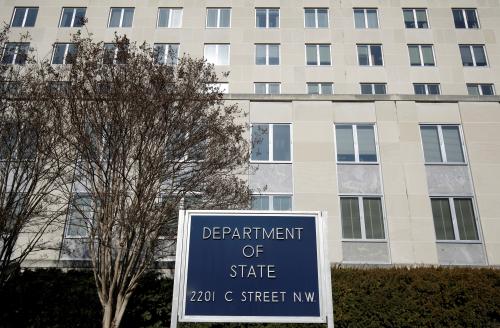The Senate’s bipartisan confirmation of Ambassador Samantha Power as administrator of the U.S. Agency for International Development (USAID) has reenergized the agency and the entire development community. While the mission of USAID has notionally been valued alongside defense and diplomacy as contributing to national security, this is the first administration to grant the U.S. development leader a permanent seat on the National Security Council. It is a critical recognition that the perspectives of both USAID and the State Department are essential and distinct enough that both voices must be heard to optimize policymaking.
Along with overseeing USAID’s $35 billion annual budget, a new and daunting challenge and exciting opportunity facing Administrator Power and her USAID colleagues is implementing some $5 billion for USAID’s global COVID-19 response. In approving that funding, Congress granted the State Department and USAID an unusual degree of flexibility—both by avoiding narrow funding categories and legislative directives and by providing greater authority to transfer funds between accounts. This should allow development professionals closer to the ground to decide how and where the funds would be used most effectively and wider use of local organizations, procurement innovations such as co-creation, and the implementation reform of adaptive management.
Locally led development
Local governments and organizations are the most knowledgeable about the needs in their communities and the landscape for addressing those needs. A recent Modernizing Foreign Assistance Network (MFAN) survey of USAID mission directors highlights the importance of working directly with local partners during the pandemic. With supply chains disrupted, international travel essentially stopped, and internal travel by noncitizens in conflict-affected countries restricted, U.S. assistance depends more on local organizations to manage the implementation and help communities protect health and economies. For example, in several instances, when schools closed, local partners assisted host-country governments and communities by developing reading and other education programs that were locally tailored and could be broadcast over the radio. In other places, missions were able to quickly disseminate COVID-19 messaging at the community level through existing local partnerships.
USAID has made progress in engaging local partners beyond COVID-19 response. Three years ago, USAID invested 35 percent of its funding under the President’s Emergency Plan for AIDS Relief (PEPFAR) directly to local partners, an amount that increased to 45 percent in the fiscal year 2019 Country Operational Plans (COP19). Current estimates show USAID will channel 53 percent of its PEPFAR funding to local partners in COP20, with a trajectory headed north of 60 percent in the next year.
Co-creation
While the principal focus of efforts to ensure the effectiveness of U.S. development cooperation over the past decade or so has been on high-level policies and principles, more recent efforts have extended to improving the mechanisms to design programs. At its heart, this has been the improvement of procurement and partnering processes through more open, collaborative instruments such as co-creation. USAID’s latest Acquisition and Assistance (A&A) report found progress in procurement reform, with over $880 million through 314 awards using co-creation in FY 2020, an increase of 36 percent.
What is leading this momentum? According to Anar Khalil, a contracting officer at the USAID mission in Bangladesh, “We looked at past programs and realized that the traditional design process—from the moment we put together a concept idea to procurement—takes 18 months to two years. So by the time the project is awarded, these ideas are old.” He is convinced that the agency’s traditional method of project design limits innovation, creativity, and responsiveness because of cost and limited partner engagement. Originally a skeptic, today he is a true believer in the technique of co-creation for bringing together a variety of sometimes competing potential partners to come up with solutions.
Brian Bingham, of USAID’s Global Development Lab, reports that the co-creation process generally brings deep value to projects and stakeholder relationships. “We found that co-creating with our partners establishes much better working relationships, better projects, and helps us know better what we’re looking for.”
In the case of USAID Morocco, Fatimezzahra Massaq, president of an organization advocating for children with disabilities, says the variety of community, government, and private-sector participants results in a superior analysis of the problems. In addition to providing a more complete picture of needs and potential solutions for the region, co-creation offers an opportunity for participants to learn about other sectors. The variety of backgrounds brings fresh perspectives and open exchange of information that does not always happen with traditional partners who have been through the proposal-writing process many times.
These advances in the use of co-creation build on strategic and structural strengthening in recent years. For example, 77 Missions have submitted New Partnership Initiative (NPI) Action Plans that set goals for bringing new partners into procurement actions, including engaging new, underutilized, and local partners. Further, the A&A Bureau (responsible for procurement) has established senior regional advisors in the bureaus for Africa, Asia, and the Middle East to strengthen the A&A workforce and increase its familiarity with co-creation and adaptive management.
The agency has issued a Co-creation Field Guide that sums up the benefits of the approach. Co-creation can increase return on investment, bring together greater intellectual resources with a breadth of perspectives that can challenge assumptions, and create shared ownership. Further, it creates a space for USAID to engage actively with prospective partners to build trusting relationships, learn from local knowledge, break down traditional power dynamics, and hold candid conversations to improve programmatic designs and outcomes.
Adaptive management
Equally important to the effective delivery of development assistance, but at present in a more formative stage, is Adaptive Management—placing greater authority and flexibility in administering activities in the field. Development is not a static process, and in many developing countries, especially where instability and conflict reign, adaptive management allows implementers to adjust activities in what are often rapidly changing circumstances. The Congress in the Global Fragility Act of 2019 recognized the need, but did not provide the authority or mechanisms, for greater flexibility in implementation.
Arc of development effectiveness
Improving the effectiveness of U.S. development assistance is not a one-time fix. It is a continuous journey fueled by learning—learning from success and missteps. Understanding that development requires countries and societies to change, USAID leadership and staff have understood more than other U.S. government agencies that the successful pursuit of its mandate requires that its processes be constantly assessed and renewed through evaluation and learning. The current journey of change at USAID can be traced as far back as Congress enacting the New Directions legislation in the early 1970s and USAID under the Reagan Administration moving beyond a focus principally on economic factors to social analysis to account for the culture and social needs of a society.
The current path of reform was kick-started in the George W. Bush administration with the creation of the Millennium Challenge Corporation (MCC) and PEPFAR—both built on accountability, transparency, local ownership, and data-driven decisionmaking. These principles were further advanced and extended to all U.S. development programs in the Obama administration and continued under the Trump administration.
The Biden administration and Congress have the opportunity to advance the journey further—to make locally-led development, co-creation, and adaptive management widespread approaches of U.S. development cooperation. One step would be to maintain co-creation as a priority for USAID and advance its usage by at least 20 percent each of the next several fiscal years. Another would be to move adaptive management from concept to reality—giving the field not just the authority but the mandate to adjust activities according to changing circumstances and learning. A third step would move USAID’s procurement processes further away from static, overly prescriptive requests for proposals through the expanded use of more flexible procurement mechanisms like co-creation; Annual Program Statements (APS) (designed to better engage private sector participation); Statements of Objectives (SOO); Refine and Implement, Performance Work Statements (PWS); and Broad Agency Announcements (BAA).
The flexible global COVID-19 response funding is a perfect opportunity, and a daunting challenge, that provides Administrator Power and USAID with the best chance in years to demonstrate the full value of these innovative approaches to delivering development.







Commentary
Making COVID-19 aid effective by doubling down on USAID reforms
May 3, 2021